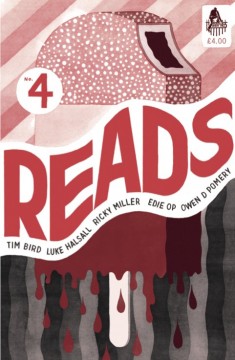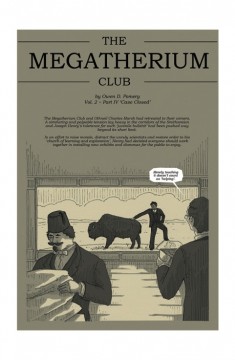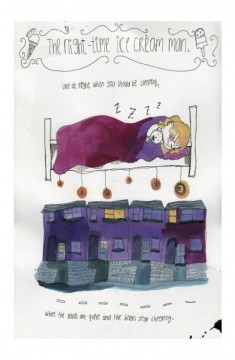“It means lots of good things to Read” we talk about the meaning of Avery Hill’s Reads with creators Ricky Miller, Edie OP, Tim Bird, Luke Haskell and Owen D Pomery
 Alongside their high profile releases, Artificial Flowers and A City Inside, Avery Hill are also releasing the 4th issue of their acclaimed (and highly underrated) anthology Reads this spring. Unlike most indie anthologies, Reads features 4 recurring tales, with topics as diverse as silver age comic creators, the history of cinema and drunk Victorian archaeologists. We catch up with editor Ricky Miller, along with creators Edie OP, Owen D Pomery, Tim Bird and Luke Haskell to find the secret to a good read(s).
Alongside their high profile releases, Artificial Flowers and A City Inside, Avery Hill are also releasing the 4th issue of their acclaimed (and highly underrated) anthology Reads this spring. Unlike most indie anthologies, Reads features 4 recurring tales, with topics as diverse as silver age comic creators, the history of cinema and drunk Victorian archaeologists. We catch up with editor Ricky Miller, along with creators Edie OP, Owen D Pomery, Tim Bird and Luke Haskell to find the secret to a good read(s).
 Tell us a bit about the inspiration for Reads and how you all got involved?
Tell us a bit about the inspiration for Reads and how you all got involved?
Owen D Pomery: The original Reads series was Avery Hill’s first foray into a comics only publication. It was a little incoherent and sporadic in its early incarnation, but it had enough charm that the idea definitely warranted a reboot with a new look and vision. I was very happy to be involved in this second volume, not least because it was an early Reads issue that showcased the first time The Megatherium Club ever appeared in print.
Luke Haskell: I first got involved with Reads after getting a review copy of volume 1, issue 1 for geek syndicate. I was instantly amazed by the quality throughout the book. I thought I would give a go at submitting a script. I was successful and got a short story into volume 1, issue 3. Then I started to think about the bullpen and talked to ricky who suggested reads. As soon as he said that I thought this would be the perfect place to showcase the story.
Tim Bird: I’d worked with Luke before on a short anthology piece, so I knew he wrote good comics. He’d pitched a script to Ricky who suggested serialising through this run of Reads. Ricky passed the script to me to see if I’d be interested in illustrating it, I liked the look of it, so agreed to do it! Not long afterwards Ricky mentioned that he was looking for an artist to draw his story. I’m a big fan of Hitchcock films, so jumped at the chance to work on this story.
Edie OP: It was one of the first anthologies I was asked to create for which was really exciting and I think (if memory serves me correctly) I was working on Maleficium in secret at the time so it was a really good time for me to work on some shorter length comics as well. I work on a lot of project ideas constantly even if they don’t have plans and at the time I was invited to submit something for Reads I was working on this ‘big book of beasts’ haha which was basically me doodling/creating backstories for monsters which is where Lucius Jellybean was born.
What does the title Reads mean to you?
Ricky Miller: For me it’s always been about good narratives. That’s been the key driver of every strip we’ve had from both the first and second volume. Lots of strips in anthologies can be quite slight due to the nature of the format, but we’ve always ensured that they’re brimming with ideas and story content.
EO: ‘Lots of good things to Read’ is genuinely what I think when I see it! Which I think is great because it gives freedom for the themes and media inside the anthology hopefully surprising the readers with a good mix of things to read!
OP: I like that Reads is trying something a bit different to the normal scattergun approach of most anthologies. It credits that reader that has invested in the idea and followed the series, hopefully giving an overall more rewarding experience. Plus I still think it displays a wide variety of styles and content despite there being relatively few creators involved.
LH: To me Reads means different, diverse and has a vibe to it that was right on the cutting edge.
TB: Late nights.
 It’s more of a serial than an anthology with 4 stories told over 4 issues, was that always part of the plan? And do you think that works better than having just an eclectic bunch of stories? Does it help you tell more developed stories as a result? (Apart from Edie of course, whose stories are all different!)
It’s more of a serial than an anthology with 4 stories told over 4 issues, was that always part of the plan? And do you think that works better than having just an eclectic bunch of stories? Does it help you tell more developed stories as a result? (Apart from Edie of course, whose stories are all different!)
RM: We’d tried to do different strips by different creators in an earlier incarnation of the anthology, but found it’s pretty hard to keep an identity for it like that. Also, it’s a LOT of work finding creators and putting it all together. So the idea of 4 strips, vaguely continuous, with the same creators, for 4 issues was partly born out of aesthetics and partly out of laziness. The key thing tying it all together is to have the same cover artist each time, if you’ve got Eleni Kalorkoti doing your cover, then you know everything will be okay.
EO: The developed stories are great, I think it’s good to have that connectivity to link everything together even if mine don’t follow the same story. At the time I was working on Reads it was quite early on in my comic creating and I’d never made anything more than a couple of pages long except my zines, so I thought potentially creating a series badly was more of a risk than creating 4 stand alone comics on the same theme that I knew I could do, if I had another opportunity like this I would definitely create a short series.
OP: In terms of The Megatherium Club, the format was ideal. Essentially the story is a series of capers and it was nice to break these up to have one small arc per issue, with a larger overarching story running across all four issues. I like to think that each one can be enjoyed in isolation with extra depth and reward coming from reading the whole series.
 Luke and Tim are we right in thinking that The Bullpen is based on Marvel in the 60s? What drew you to that particular story and were there any particular challenges in changing the names etc. to keep it on the right side of the law? Are you big Lee/Kirby fans?
Luke and Tim are we right in thinking that The Bullpen is based on Marvel in the 60s? What drew you to that particular story and were there any particular challenges in changing the names etc. to keep it on the right side of the law? Are you big Lee/Kirby fans?
LH: First of all I am a huge Kirby fan. He is one of my main inspirations when it comes to writing. An innovator and a genius. The bullpen is based on a number of creative teams where there are differences in opinion as to who did what. I love reading about the history of comics and had done a lot of research into various creative teams and their differing view points. I also took inspiration from other areas such as tv shows where there has been dispute over who did what etc. It does often get seen as a homage to the silver age and that was a deliberate choice by setting it in the late 50s. The 50s and 60s is a time that fascinates me and I felt it would be interesting to look at how something was created. As comics was the medium of choice, comics felt the right suit. Overall I see the bullpen as a character piece, in the same vein as say mad men or breaking bad.
TB: I didn’t know much about this era of comics – I was drawn to the characters Luke wrote about in The Bullpen. There’s a great tension between Jack and Bill, who both have interesting back-stories and family lives that unfold in each issue. I liked the way Luke incorporated aspects from the fictional comic The Nucleus into the story he was telling in The Bullpen.
We love the the flippant sense of humour in The Megatherium Club, it really opposes the traditional Victorian style imagery. Did you find yourself having to reign yourself in when it came to those? And did you base it on real events and characters or just create your own for the story?
OP: The Megatherium Club were a genuine group of scientists who gained notoriety in the 1800s for their improper behaviour. There are lots of great existing stories to tell, however, things that would have been shocking in those times would still seem quite tame by today’s standards, so the use of modern language helps to break through the austereness of the time period and hopefully show them as the unconventional characters they really were. Even though it is exaggerated, the start point for everything is always based in fact, so there was a lot of research into the characters and situations that are then built on and twisted for effect. Essentially there are lot of ‘rules’ I set myself below the surface, particularly with the narration, that allows the seemingly anarchic story to stampede through unrestricted.
 Hitchcock & Film is amazingly detailed, how much research did you have to do to get it accurate? And what was it about Hitchcock’s early days that made you choose to juxtapose it with the history of early cinema?
Hitchcock & Film is amazingly detailed, how much research did you have to do to get it accurate? And what was it about Hitchcock’s early days that made you choose to juxtapose it with the history of early cinema?
RM: I started off doing a LOT of research. I went to the British library and read lots of books and articles, made masses of notes…then had to jettison most of it for space reasons. I love the subject so it was no hardship. The whole thing was just going to be about Hitchcock, but through just some cursory initial research it became clear that Hitchcock’s story, at least until the 1940s, was also the story of film. I had planned to try and span his whole career, but I got way too interested in the early, British stuff and so decided to make it just about that in order to do that vaguely properly, rather than trying to be exhaustive.
TB: Ricky did all of the research, really. His scripts are very detailed including reference images – he had a very clear vision of how he wanted to present the comic. I just used it as an excuse to watch films!
Tim, how did you end up doing double duty on this book?
TB: Ricky’s a very persuasive editor. (And he holds a lot of meetings in the pub).
Edie: how does creating short little stories like those in Reads compare to your long form graphic novel Maleficium? Which medium do you prefer?
EO: At first I really enjoyed the short stories and they were a huge challenge, and Maleficium was like my Everest haha. But now I find short stories really difficult, I have so much I want to say I struggle to squash it into under 12 pages. Even when I look back now Maleficium seems quite small, but I couldn’t say either which I really prefer because I love created both short and longer length comics.
 Is your hand drawn style particularly labour intensive?
Is your hand drawn style particularly labour intensive?
EO: Yeah the hand drawn style is pretty labour intensive, but I run it like a factory line, so I will usually draw all the base first, then go through and add the first layer of whatever I’m using (usually wet media so it needs to dry) when keep working like that until I’m adding detail and text. But I love it. When I first started out I had quite a few people telling me that I can’t maintain that aesthetic in comics because it’s not practical, but it’s not slowed me down too much yet!
You’ve brought Reads to a conclusion with issue 4, so will we be seeing more issues soon? Will they feature the same characters, creators and stories or will it be something completely different?
RM: We’re very fond of the title and there’s definitely a case for having an Avery Hill showcase book, so I wouldn’t be surprised to see it come back at some point. If it does, then it will definitely be a totally different format and content; but still full of great reads!
Reads #4 will be available from Avery Hill Publishing on May 7th – you can pre-order it here now as well as purchase the first 3 volumes.


